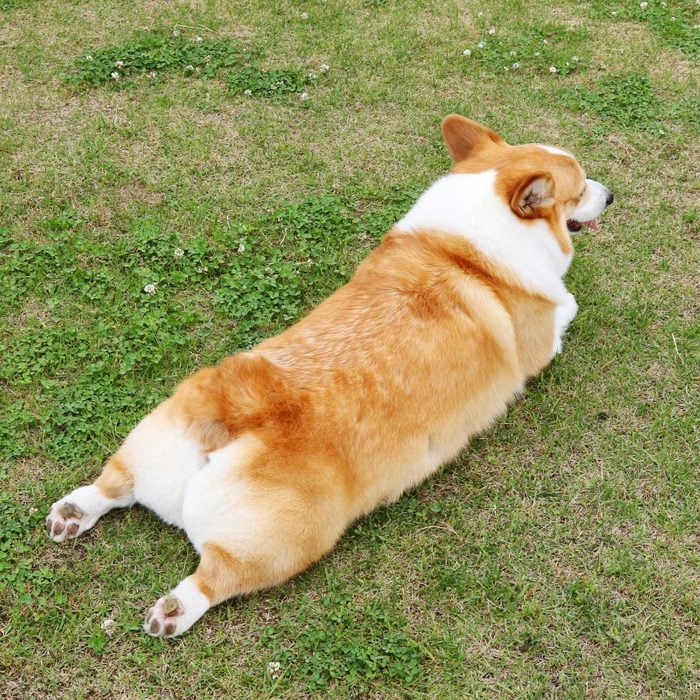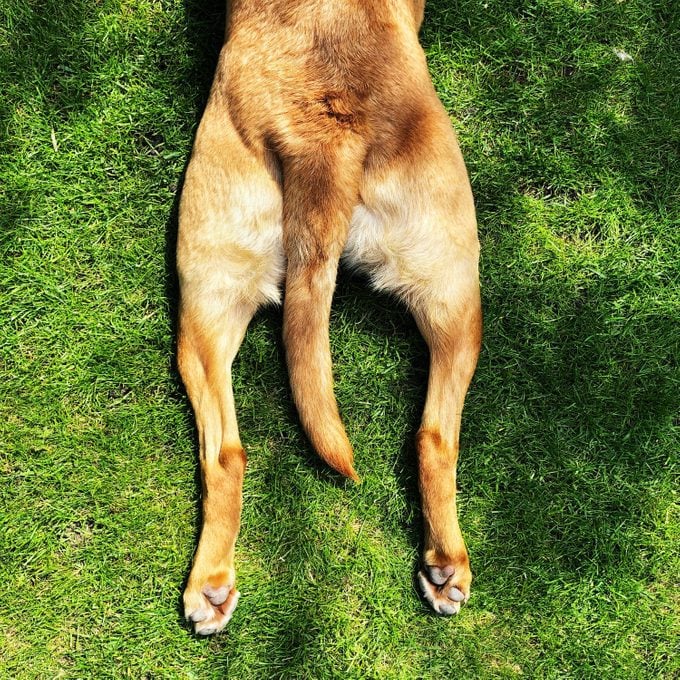Why Do Dogs Sploot? Veterinarians Explain the Cute Canine Behavior
Updated: Mar. 05, 2024

This adorable pose can be more than just entertaining to humans. Why do dogs sploot, and when might it be a sign your dog has a health issue?
Our pups have a knack for expressing all kinds of dog behavior through facial and body language, including their dog sleeping position. One of the cutest things they do is the dog sploot, and we’ll get into more about what that is in a minute. Seeing your dog in this unnatural position is so adorable—and yet kind of strange—so you might wonder if dog splooting is normal. “Most dogs sploot because they are keeping cool, stretching out and relaxing,” says Linda Simon, MVB, a veterinarian at Senior Tail Waggers. Well, that’s a relief.
Still, there are times when splooting could be a sign that something is amiss, which is why learning more facts about dogs can help us understand them better. Once you’re in the know about the hot topic of splooting, you may also want to know more about why dogs drag their butts too.
What is splooting?
“Splooting, or ‘frogging,’ is defined as the posture a dog takes when their belly is flat against the ground and their hind legs are stretched out behind them,” says Jamie Whittenburg, DVM, veterinarian director at Senior Tail Waggers. While frogging is also an accurate description, sploot and splooting just sound cuter. But where did the word sploot come from?
Who coined the word is a mystery, but Dictionary.com says that lexicographer Grant Barrett suspects sploot may stem from “splat,” to describe the appearance of the pose. The word sploot may be part of a growing vocabulary of doggy slang that uses cute, deliberate misspellings to lovingly describe our dogs’ quirks, physical appearance and more. We sub in chonky for chunky and floof for fluffy, for example.
Why might a dog sploot?

Most dogs lie on the ground this way to feel good. While it’s not common, a splooting dog may have certain medical conditions too. Here are a few reasons why dogs do it.
To stretch and relax
Dogs know splooting feels good, but you might be wondering why it does. This cute doggy pose can relieve tension or pressure on their lower back and hips and stretch and help align their spine. “Splooting requires flexibility of the hip joints as well as the muscles in the hind legs,” says Dr. Whittenburg. “Dogs tend to [go into] this position when they are relaxed and comfortable.” Usually, puppies and younger dogs have an easier time sprawling out into a sploot, but you might see older dogs doing it too.
To cool off
Though panting is the primary way to cool down after a lightning round of dog zoomies or a long walk on a hot day, some dogs may sploot to drop their body temperature. “Dogs cool their bellies on the floor, since they don’t sweat like humans do,” says Marla Beach, DVM, lead veterinarian at CityVet Flower Mound.
Woofers who sploot may seek out surfaces like cold tile, wood flooring or a grassy area in the shade. “The dog stretches out and gets more of their abdomen in contact with cooler ground in an effort to dissipate more heat,” says Dr. Simon. If your hot pup doesn’t have access to a cool floor, then a cooling dog bed or other dog cooling products can help your dog feel more comfortable.
The dog has short legs
Various dog breeds can do the dog sploot, but the adorable short-legged dog breeds naturally ease into this yoga-esque pose more comfortably than other breeds. For example, the body of corgis, dachshunds and French bulldogs allow for a greater range of movement in the hip joints, making it easier to stretch their hind legs. “The anatomical structure of their hips and joints may be more flexible, enabling them to adopt positions like splooting more effortlessly compared with breeds with different body proportions,” says Dr. Beach. Still, even if you have a dog breed known for splooting, each dog has their favorite stretch, and splooting may not be one of their go-to moves.
The dog has hip dysplasia
It’s rare, but joint problems such as hip dysplasia, a deformity of the ball and socket joint of the hip, may lead to splooting in some cases. But there should be other signs that the dog has hip dysplasia too. “When splooting is associated with hip dysplasia, we may notice a ‘bunny hop’ run, stiff walking or reluctance to play,” says Dr. Simon.
Hip dysplasia is typically seen in larger dog breeds. During puppyhood, the ball and joint should grow at equal rates. When they don’t, the joint has too much laxity, which causes pain that may lead to degenerative joint osteoarthritis or joint disease. Treatment options include medicine, supplements, physical therapy or surgery.
The dog has arthritis
If your older dog has never splooted before, they’re probably not doing it to relax or cool down. “Splooting would not be an expected new behavior in an older dog,” says Dr. Simon. “Rather, when the behavior starts in their senior years, this would be a sign of an emerging medical issue such as arthritis.” Arthritis is a common health issue that can severely limit your dog’s quality of life as they get older. It can cause the bones and joints to rub together due to tissue damage or cartilage loss.
Since dogs can’t speak to us to say they’re hurting, pet owners have to look for warning signs that they are in pain. Dogs may have difficulty getting up after sleeping or napping, have less interest in walking or playing or have a limp or overall stiffness. When your dog is in pain, they might not want to be touched or petted and be a bit cranky. Speak to your vet right away if you notice any of these symptoms. With arthritis, the most effective pain management for dogs begins sooner rather than later.
Is it OK for dogs to sploot?
Overall, splooting is harmless and doesn’t cause pain. Though it’s important to know that every dog is different, and while splooting may be the ultimate way to stretch and relax for one dog, it might not ever be another dog’s thing. “Certain dogs may have physical limitations or conditions that make splooting uncomfortable or even painful for them,” says Dr. Beach. Additionally, dogs with joint issues, muscle strains or injuries may find certain positions, including splooting, uncomfortable.
When should I worry about a dog splooting?
Generally, dog splooting is nothing to worry about, but if you have an older dog that has never splooted before and begins to do so, this should sound an alarm bell. “Older dogs are more prone to certain musculoskeletal diseases, including arthritis and ruptured knee ligaments,” says Dr. Simon.
For dogs of any age that have never splooted before, have difficulty getting up, appear to be in pain or are showing signs of heat stroke in dogs, seek veterinary care right way, adds Dr. Whittenburg.
Next, find out what a yellow ribbon on a dog’s collar really means.
Sources:
- Linda Simon, MVB, MRCVS, veterinarian at Senior Tail Waggers
- Jamie Whittenburg, DVM, veterinarian director at Senior Tail Waggers
- Marla Beach, DVM, lead veterinarian at CityVet Flower Mound
- Dictionary.com: “Sploot”



